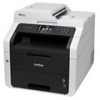Brother International MFC-9340CDW Users Manual - English - Page 45
Envelopes, Types of envelopes to avoid
 |
View all Brother International MFC-9340CDW manuals
Add to My Manuals
Save this manual to your list of manuals |
Page 45 highlights
Envelopes 2 The machine is designed to work well with most envelopes. However, some envelopes may have feed and print quality problems because of the way they have been made. Envelopes should have edges with straight, well-creased folds. Envelopes should lie flat and not be of baggy or flimsy construction. Use only quality envelopes from a supplier who understands that you will be using the envelopes in a laser machine. Envelopes can only be fed through the manual feed slot. We recommend that you print a test envelope to make sure the print results are what you want. Types of envelopes to avoid 2 IMPORTANT DO NOT use envelopes: • that are damaged, curled, wrinkled or an unusual shape • that are extremely shiny or textured • with clasps, staples, snaps or tie strings • with self-adhesive closures • that are of a baggy construction • that are not sharply creased • that are embossed (raised writing) • that were previously printed by a laser or LED machine • that are pre-printed on the inside • that cannot be arranged neatly when stacked • that are made of paper that weighs more than the paper weight specifications for the machine • with edges that are not straight or consistently square • with windows, holes, cut-outs or perforations Loading paper • with glue on the surface as shown in the figure below 2 • with double flaps as shown in the figure below • with sealing flaps that are not folded down when purchased • with each side folded as shown in the figure below If you use any of the types of envelopes listed above, they may damage your machine. This damage may not be covered under any Brother warranty or service agreement. Occasionally you may experience paper feed problems caused by the thickness, size and flap shape of the envelopes you are using. 31















